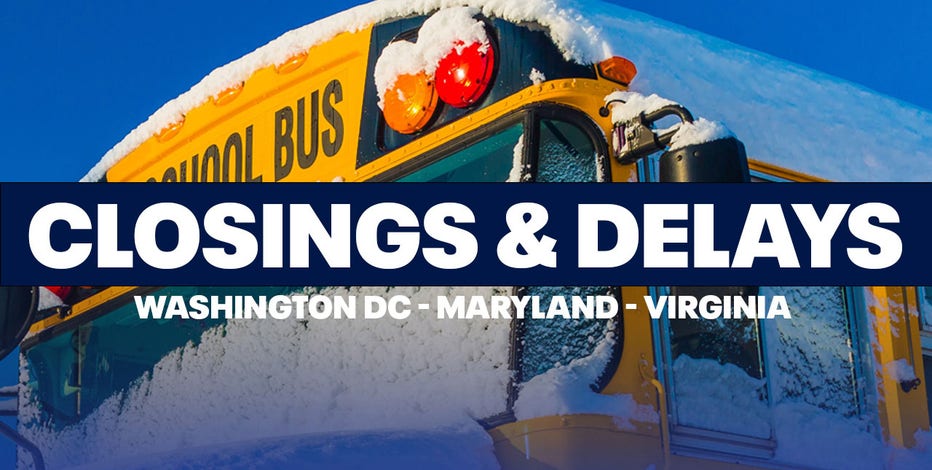DC snow emergency guide: How to navigate snowfall in the DC region this winter

How to stay safe on the roads when there's snow
Area police saw a lot of spin outs in this morning?s icy and snowy conditions. We?ve got our FOX 5?s Stephanie Ramirez live in Rockville speaking with a driving expert on what to do ? and most importantly, what not to do hitting the roadways.
WASHINGTON - A consistent snowfall is underway in the D.C. region and road conditions, closings and delays, along with the snow accumulation are all major concerns.
READ MORE: DC snow forecast: How much has fallen and how much more to expect Friday
Here's everything you need to know about staying safe in winter weather:
How to drive in the snow
Driving in winter storms or bad weather can be very dangerous and is a factor in nearly half a million crashes and more than 2,000 road deaths every winter, according to AAA. To help minimize potential risk, drivers are advised to adhere to the following recommendations.
Drivers should ensure their tires are properly inflated and have plenty of tread when driving in winter weather. Drivers are advised to keep at least half a tank of fuel in their vehicle at all times during the winter.
READ MORE: Best sledding and tubing spots in DC, Maryland & Virginia
If possible, stay home and off the roads. Drive slowly in inclement weather and adjust your speed. Also, increase your following distance from five to six seconds. Do not stop if you can avoid it or while driving up a hill.
The National Weather Service advises drivers to create a vehicle emergency supply kit that will better prepare you for winter weather. When planning for snowfall, it's important to keep in mind that winter storms can include extreme cold temperatures, freezing rain, sleet, large amounts of snowfall, ice, high winds.

Virginia road conditions: Snow covered roadways make for hazardous commute
Fast-falling snow early Friday morning has left many roadways covered in snow.

Maryland road conditions: Hazardous Friday morning commute as snow falls
A hazardous Friday morning commute as snow falls quickly across the Washington, D.C. region.
Your vehicle emergency supply kit should include a first aid kit, jumper cables, cellphone charger, water and snacks, mittens, hat, boots, warm clothes, a flashlight, snow shovel or brush, blankets, tow-rope, flares, and a spare tire.
How to winterize your home
Ahead of winter, it's important to make sure you are able to safely heat your home. As suggested by the American Red Cross, your home should be equipped with a 1-month supply of needed medications and medical supplies. Along with having a vehicle emergency supply kit, you should also have an at-home emergency kit. This kit should include batteries, a charger, a first-aid kit, along with other essentials.
Stock up on a supply of food, water, and medicine before a winter storm.
Be sure to wear layers of clothing and keep warm blankets nearby. Ensure that you have a snow shovel and ice-melting products in order to keep a clear entry into the home.

Snow shoveling safety tips
Shoveling can get risky for your health. Here's what you need to know to stay safe.
How to tackle snow clean up
When it comes to shoveling, it's important to take it slow and even stretch before you begin. It's reccommended to only shovel fresh and powdery snow along with using a small shovel. D.C. officials recommend applying deicer or rock salt to your sidewalk and steps to make clearing snow and ice easier after the storm ends.
Push don't lift! The appropriate posture and techniques are extremely important when it comes to safe snow removal and preventing injury. Experts recommend keeping your shovel close to your body while shoveling, bending with your knees and lifting with your legs rather than straining your back, and keeping your hands farther down on the shovel’s handle.
READ MORE: DC snow forecast: How much has fallen and how much more to expect Friday
Shoveling help is available for D.C. homeowners who are 65 or older/or residents with disabilities, access, and functional needs from Serve DC’s DC Volunteer Snow Team. Anyone who needs assistance is asked to contact Serve DC at 202-727-7925 to sign-up for the DC Volunteer Snow Removal Program.
Shoveling help is available for Winchester residents that are senior citizens (62-years-old or older) or disabled residents only. Anyone who needs assistance can click here for more information.
Check your city's website for assistance programs near you.
Featured
A timeline of the snowiest blizzards in DC, Maryland and Virginia history
We take a look at the most impactful and snowy blizzard to hit DC, Maryland and Virginia, complete with an interactive timeline, video from our archives, photos and much more!



